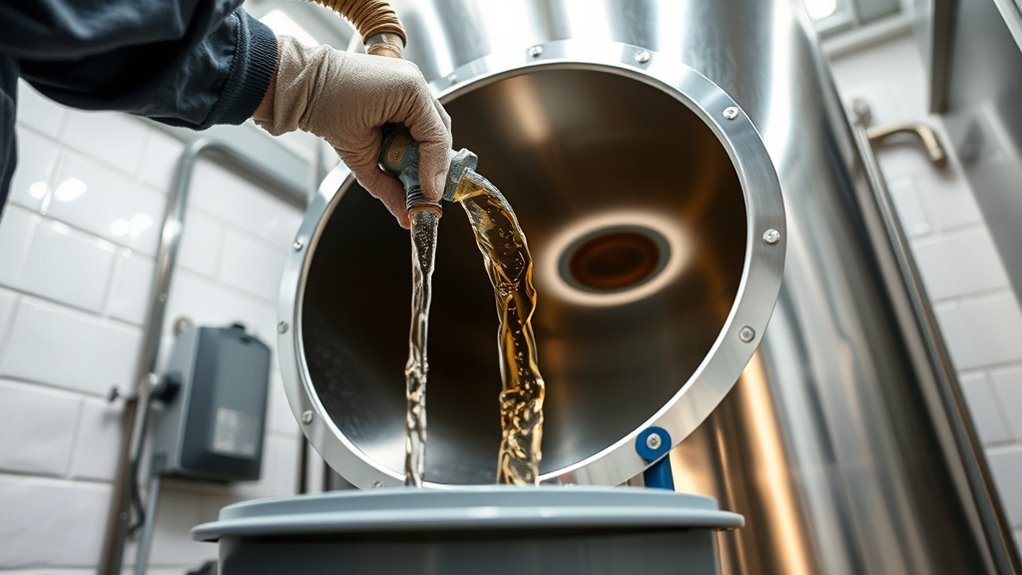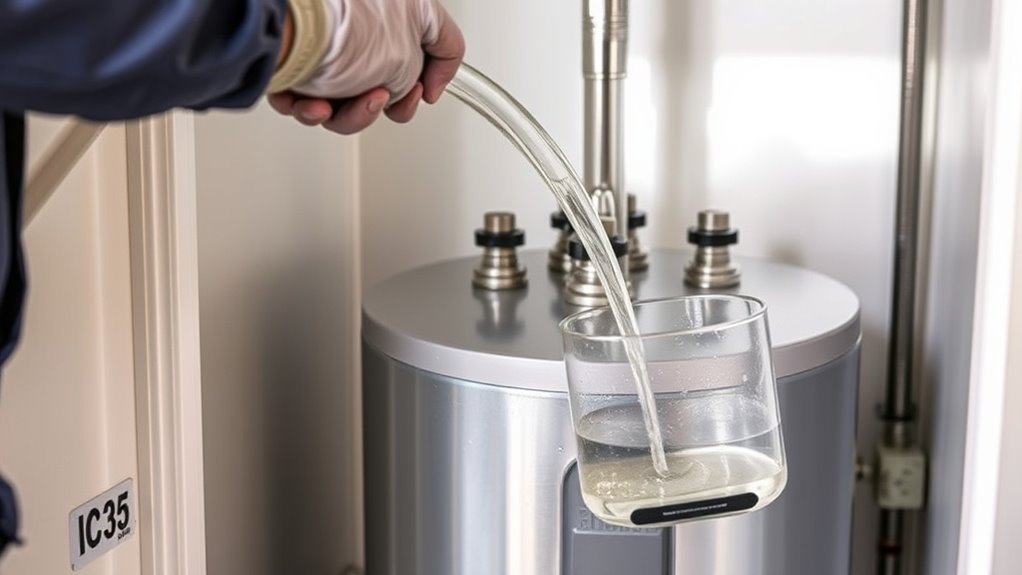Regularly flushing your water heater in about 30 minutes can boost efficiency and save you money on energy bills. Start by turning off the power, shutting off the cold water supply, and attaching a hose to the drain valve. Drain the tank, then briefly turn on cold water to stir up sediment before flushing again. Once done, turn everything back on, check for leaks, and enjoy a more efficient unit. Continue exploring to learn all the simple steps involved.
Key Takeaways
- Regularly flushing your water heater prevents mineral buildup, maintaining efficiency and extending its lifespan.
- The process takes about 30 minutes and involves draining, flushing, and refilling the tank.
- Turning off power and cold water supply before flushing ensures safety and effective cleaning.
- Flushing reduces energy costs by improving heating efficiency and prevents costly repairs.
- Consistent maintenance saves money long-term by avoiding early replacements and maintaining optimal operation.

Regularly flushing your water heater is essential to keep it running efficiently and extend its lifespan. Over time, mineral deposits like calcium and magnesium build up at the bottom of the tank, reducing its heating efficiency and increasing energy costs. If you notice inconsistent water temperatures, reduced hot water supply, or increased energy bills, it’s a clear sign that your heater needs a flush. Performing this simple maintenance task takes about 30 minutes, yet it can save you considerable money on repairs and energy consumption in the long run.
Regular flushing extends your water heater’s life and improves efficiency, saving money and preventing costly repairs.
First, turn off the power supply to your water heater. If you have a gas heater, switch the gas control to the “pilot” setting; for electric models, switch off the circuit breaker. Next, shut off the cold water supply valve at the top of the tank. Attach a garden hose to the drain valve located near the bottom of the unit. Run the hose to a floor drain or outside, ensuring it’s positioned safely to handle hot water. Once everything is set, open the drain valve to start emptying the tank. Be cautious—water will be hot, so wear gloves if necessary. As the tank drains, you might notice sediment and mineral buildup flowing out, which confirms the importance of this maintenance.
After the tank is mostly empty, turn on the cold water supply briefly to stir up any remaining deposits inside the tank. Let this run for a few minutes, then close the cold water valve and open the drain valve again to flush out residual debris. This process helps remove sediment stuck at the bottom of the tank, improving its efficiency. Once the tank is thoroughly drained and flushed, close the drain valve, disconnect the hose, and turn on the cold water supply. Allow the tank to fill completely before turning the power or gas back on. Make sure there are no leaks around the drain valve or connections.
Performing this flush regularly—once a year for most households—can substantially reduce energy costs and prolong your water heater’s life. It prevents the buildup of mineral deposits that cause the heater to work harder, saving you money on electricity or gas bills. Plus, it reduces the risk of costly repairs or early replacements due to corrosion and sediment damage. Taking just half an hour to flush your water heater not only keeps it running smoothly but also offers peace of mind that your hot water system is functioning at its best. It’s a quick, cost-effective maintenance step that pays off in energy savings and longevity. Regular maintenance also supports the efficiency of your water heater, ensuring it operates optimally for years to come.
Frequently Asked Questions
How Often Should I Schedule a Water Heater Flush?
You should schedule a water heater flush once a year to keep it running efficiently. Regular flushing removes sediment buildup that can cause corrosion, reduce energy efficiency, and shorten its lifespan. If you live in an area with hard water, consider flushing every six months. Staying consistent with this maintenance saves you money on repairs and prolongs your water heater’s effectiveness, ensuring you always have hot water when you need it.
Can I Flush My Water Heater Myself or Hire a Professional?
Flushing your water heater is like giving it a much-needed bath. You can do it yourself if you’re comfortable with basic plumbing and follow safety precautions, saving money and gaining a sense of accomplishment. However, if you’re unsure or uncomfortable working with water and electrical components, hiring a professional guarantees the job’s done correctly and safely. Assess your skills and comfort level before deciding which route to take.
What Signs Indicate My Water Heater Needs Flushing?
You’ll notice your water heater needs flushing if your hot water runs out quickly, or if you see sediment or rust in the water. Unusual noises like banging or rumbling also indicate buildup. If your water has a strange smell or discoloration, it’s a sign to flush. Regular maintenance prevents damage and extends your heater’s lifespan, so keep an eye on these signs to know when it’s time for a flush.
Are There Risks Involved in Flushing a Water Heater?
About 80% of water heater failures are related to sediment buildup, so flushing is essential. Risks are minimal if you follow proper safety steps, like turning off power and draining carefully. However, if you’re inexperienced, you might accidentally damage components or cause leaks. To avoid issues, consider consulting a professional or following detailed instructions. Proper maintenance ensures your heater runs efficiently and lasts longer, saving you money in the long run.
How Much Can I Expect to Save With Regular Flushing?
You can expect to save between 10% and 20% on your energy bills by flushing your water heater regularly. This simple maintenance removes sediment buildup, which makes your heater work harder and less efficiently. Over time, these savings add up, especially if you live in an area with hard water. Regular flushing also extends your water heater’s lifespan, preventing costly repairs or early replacements.
Conclusion
So, next time your water heater’s performance dips, don’t ignore the simple fix. A quick flush might seem like just a small task, but it can save you a lot of cash in the long run. Ironically, neglecting this 30-minute routine could cost you more than you’d think—both in money and headaches. So, why not give your heater a quick refresh? It’s a tiny effort for big savings—who knew such a simple fix could be so powerful?









